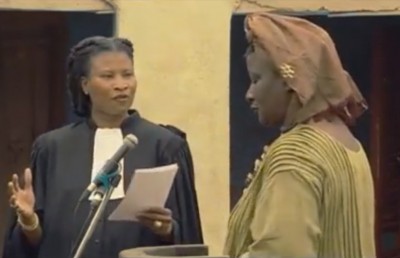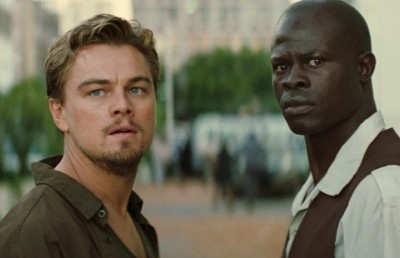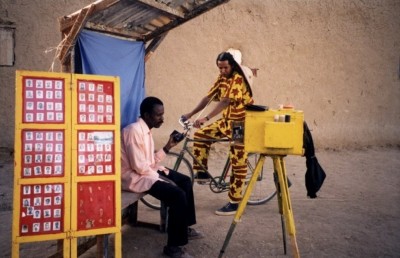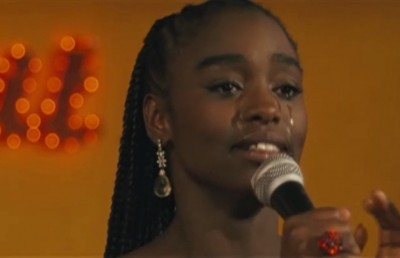Bamako
Speech, Silence, and Sometimes Death
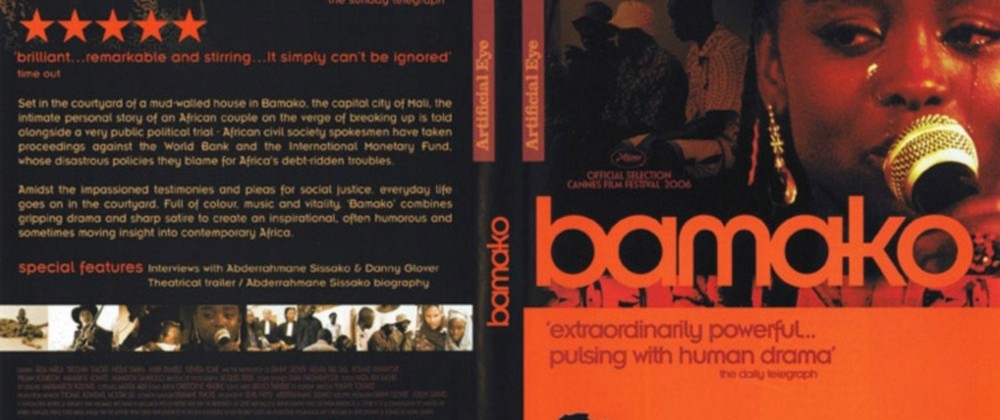
With a premise that initially seems predicated upon ethical wish fulfillment, Sissako’s Bamako (2006, Mali/France) places the International Monetary Fund (IMF) and World Bank on trial, with the African people in the role of plaintiff, and sympathetic Africans sitting on the judiciary. We quickly realize this process, in contrast to rigged trials that send people to real jail, will attempt to follow legitimate legal procedures in order to produce a symbolic verdict. This may spoil populist fantasies of a browbeaten yet unified people rising up against the so-called ‘Washington Consensus’ institutions. Verdict legitimacy aside, a deeper problem exists with this scenario: the possibility that the troubled economic fundamentals caused by misguided IMF/World Bank polices may have already turned the population against itself, thus undermining the notion of a united front. A clear distinction between harmful global institutions and the people they oppress becomes problematic when a major side effect of these institution’s economic polices includes infected interpersonal dynamics. It does not rule out the possibility of resistance, but expands the conception of what needs to be resisted to include conditions within the oppressed segment. In Bamako, this idea is given specific example with a married couple who live within the courtyard’s walls, and whose situation illustrates how widespread unemployment can produce social isolation and encourage people to view each other as means, rather than ends in themselves. Also considered in this essay is a former school teacher who arrives at the court to express his views on the proceedings, and whose experience shows how people may attempt to oppress each other for fear of tyrannical political structures. Indeed, worked into both these narrative threads is a meditation on the value of communication, with Bamako seemingly advocating for open speech with regards to interpersonal relations and a studied silence when taking an oppositional stance against misguided organizational structures.
The married couple, Chaka (Tiécoura Traoré) and Melé (Aïssa Maïga), are introduced early on in a wedding photo which shows them posing happily together, while their current state is evoked by the shadow descending on the frame’s upper border. If Sissako were a Hollywood director, this shadow might belong to the IMF/World Bank mothership, descending over Bamako and blocking out the sun. Aerial attacks, however, would be redundant given the damage already inflicted by the so-called Structural Adjustment Programs (SAPs), presumably the indirect cause of the husband’s unemployment. It is likely his seemingly terminal lack of work which has prompted his wife to spend time with another man and cut off communication, despite his earnest efforts to engage her in dialogue. While her dismissive behavior may seem cruel, the couple appear to be entirely dependent on her income as a singer. This puts her/them in an extremely vulnerable position, especially in a land forced to shred safety nets in favor of debt repayment. Indeed, the connotations of prostitution which hang over her trysts could be taken as an indication that her singing salary is already insufficient to ward off exploitation, so that her appraisal of her husband in terms of economic potential finds a direct parallel in her own chosen or coerced status as a sex object. Considering people as ends in themselves, rather than means to an end, becomes an interpersonal luxury certain IMF polices tragically place beyond the means of some people. Meaningful emotions may become a barrier to survival, and communication either pointless or too painful. Without intending to promote a condescending set of discount morals for the world’s poor, her behavior seems more rational than shrewish.
Faced with ostracization from his wife and other members of the courtyard community, who seem to regard him as an unemployed cuckold, the husband’s strategies for attaining meaningful social contact take forms which are mechanical and linguistically distancing. The first of these attempts occurs when he visits a church and finds himself exhorted into a call and response pattern of worship, delivered by an English speaking preacher and his trusty translator. Indeed, this preacher seems to enjoy the mechanical aspect of his sermon, and has devised a nifty gimmick whereby the congregation’s responses gradually speed up so as to mimic the sound of an oncoming locomotive. While this may keep some people coming back, the husband seems to find more meaningful social interaction through his language tapes, something which may be regarded as a swipe against the social utility of faith. Like the religious experience, these tapes take the form of a speak and repeat structure and occur outside his primary language. In contrast to religion, they are also intended to offer a tangible means of self-improvement through the increased employment options that come with a second language.
If some of the phrases offered by this language learning kit seem outlandish, it may be because they are designed to provide commentary on the nature of his wife’s infidelity. At one point the tape asks “Why are you looking for your wallet over there? It is too dark to see anything.” He repeats his line, suggesting his subjective thoughts, as we cut to Dakar, where his wife is dancing with the well-dressed other man. Taken literally, both sentences reference the practical act of looking for a wallet in a specific location, while subtextually the second line seems to refer not to the location of the wallet, but rather the spiritual void that accompanies the prioritization of the economic over the social. The cross-cutting of the husband and wife, combined with her bored expression while dancing, also reinforces the notion that this couple still have some mutual attachment and belong together in a manner found in the photo (sans shadow). In addition to the limited social satiation obtained via the tapes, this brief scene touchingly reveals the husband’s vulnerability and attachment to his wife, whom he seems to know is with another man, perhaps because of the financial shortfall caused by his unemployment.
The character in Bamako who capitalizes on the husband’s vulnerability arrives in the unlikely form of an unemployed police videographer in need of a crime scene. He is present for the trial on business, though unofficially given that his entry depends on bribing the guard. As he derives financial benefit from the dead, and is a trained criminologist interacting with an obviously depressed man, his idealization of death seems designed to push the husband towards suicide: the husband’s death would give him something to film. At first he praises the stillness to be found on the faces of the dead, and the husband only listens. Later he simply states that “death is good,” and begins slowly nodding his head. The husband does the same.
In addition to pushing the husband towards destruction through the idealization of death, the videographer undermines the value of the language tapes, and so pulls the husband away from constructive improvement. With a small measure of pride, the husband shares that he is learning Talai in preparation for work as a security guard should an Israeli embassy opens in Bamako. Talai is a language spoken by the Kalenjin clan in Kenya, and seems to bear no relation to this stated intention. While the videographer presumably sees the disconnect, he says nothing, preferring to express his opinion through sustained laughter. The husband continues reading, stoically but presumably not without shame. This situation would be comical if it did not represent one of the husband’s last measures of hope.
While the videographer’s stalking of the potentially dead seems to imply conscious malice, Bamako, by analogy, suggests this inclination may be determined in a way that is not obvious or consciously known. This idea is suggested by analogy during the prosecutor’s closing arguments. He explains that the IMF/World Bank’s “murderous instinct” may exist because organizations have an unconscious tendency to work in a way that maximizes their own interests, which in this case would be the West’s looting of Africa. This argument constitutes a third position, seemingly wedged between the opposing views of IMF as either intentionally malicious or motivated by genuine altruism. This argument may also hold at the level of the individual and, in addition to the videographer, could apply to the wife. This idea regarding the prioritization of one’s own needs is evoked in the scene of the husband’s suicide. He shoots himself in the early dawn, when it is almost too dark to see anything. A car in the background comes to an abrupt halt, a man exits, and with concern checks his motor, thinking the firing may have been caused by an engine problem. While he could not have known the sound was a gunshot, the scene visually suggests a certain way of thinking.
Bamako concludes with the husband’s funeral, filmed in large part through the videographer’s lens, with little sound except for that of the rolling tape. In one sense, this approach seems consistent with the behavior of the people standing in silence before his coffin, showing a respect sadly absent during his life. These traces of respectful memorial silence, however, are undermined by their mediation through the videographer’s camera, recalling as it does his role in the husband’s decision to kill himself. When peering though his camera’s viewfinder, his way of closing one eye pulls at the edges of his mouth. This resulting grin, however, seems just a little too eager to be mere anatomical side effect, and recalls his previous comments on the beauty of silent, dead faces. The negative connotations which inform the filming of the husband’s death are not, however, limited to the involvement of the videographer. They extend to the husband’s larger experience of social alienation, which is, at least partially, triggered by structural economic shortcomings. Communication is not inherently good, but an absence of a constructive social interaction tends to heighten the effectiveness of destructive efforts. The videographer’s success owes itself to the husband’s vulnerable state, made possible through social isolation, and not to the intrinsic allure of suicide (as the videographer says, “death is good”). The videographer is exploiting a weakness which he did nothing to create, and without which he would have little power.
While this scene implies the need for open interpersonal communication, the former school teacher advocates remaining closed when dealing with bureaucratic structures, which in this case includes the trial. After stating his profession for the court, he is asked if there is anything he would like to add, and he walks away from the podium. The primary message in this action seems to be that speaking is either meaningless, given the merely symbolic nature of the verdict, or dangerous if a neutered ‘guilty’ ruling were to provide a sublimated sense of justice that could undermine attempts at substantive change. With the latter possibility, a guilty verdict could ironically be of greatest benefit to the IMF/World Bank, something which makes the equation of the court and these institutions reasonable. In addition to these issues, potential danger also arises in the application of what witnesses say, as can be seen in the testimony of a professor. Describing social attitudes, he says that people may come to believe that “death is better than shame.” This comment occurs on a cut to the husband and videographer, perhaps legitimizing the latter’s self-serving arguments. Regardless of intentions, and distinctions between descriptive and prescriptive observations, it could be understood as promoting suicide. Silence might have been better.
In contrast to the former school teacher’s rejection of allegedly constructive speech in a institutionalized context, is his attempts at seeking counsel in a more personal setting. Outside the courtyard he asks a friend for advice about a troubling, recurring dream. He explains how in this dream he is sitting in front of a bag containing the severed heads of political leaders, or heads of state, as he calls them. His friend asks if the heads are black or white. As he replies that he does not know, the image cuts to the space in-between these two men, tightly isolating the head of a prostrate third man in the space visible between them, which carries connotations of decapitation and, given that the man is black, a possible response to the friend’s question. The friend advises that he not repeat the dream to anyone else. It seems the friend’s warning is based on the dream’s undertones of sedition, and is advocating a suppression of speech that may characterize life under brutal regimes populated by citizens who may profit from relaying information. The man lying down has heard the dream, and the possibility that he will share this information produces a vague sense of danger that is reinforced when, immediately following this warning, a police officer investigating the stolen gun takes the former school teacher aside for questioning.
By his silence in the court and request for advice outside of it, he reveals his desire to avoid institutionalized communication while seeking it within the social sphere. Such a distinction, however, proves untenable given the intrusion of political structures into the social sphere. While the above scene references military dictatorships, a similar subversion of open communication is linked to the social environment encouraged by the oppressive, autocratic approach of the IMF/World Bank. This can be seen when the prosecution argues that if a certain witness had come forward with the paper evidence of a destructive IMF policy, which she was only verbally relaying at the trial, that the result would have been her imprisonment. In addition to the nature of the verdict, this also illustrates the difficulty of constructive speech within this setting. Life under the IMF/World Bank is linked with that of military dictatorships and, going further back, colonial rule. Indeed, the bag of heads likely references the severed political autonomy of leaders forced to abide by the imposed dictates of remote policy makers.
Bamako looks at the relationship between global financial institutions and the people affected by their polices. In many cases, most obviously during the sustained testimonies, the approach is overtly didactic and highly critical of these Western interventions. In opposition to both these tendencies, other moments which occur outside the formal arena of the court are characterized by Sissako’s characteristic ambiguity and take as their theme the ways in which Africans may inflict harm from within, though such approaches may in their turn be rooted in economic conditions encouraged by reckless policy. In discussing Sissako’s relation to the African cinematic tradition, Armes notes that the director’s tastes are highly westernized, and that the “difference between Sissako’s approach and that of the pioneers was very clear too when he admitted to an interviewer that what interests him in cinema is ‘poetry, but not necessarily revolutionary poetry’”(192). Bamako may not be revolutionary, but it does seem to take Sissako’s work in a more political direction, and fortunately not at the cost of poetry. While the IMF/World Bank’s contribution to globalization seems dubious, the cultural overlaps apparent in Sissako’s work remain a source of hope.
Bibliography
Armes, Roy. African Filmmaking, North and South of the Sahara. Indiana: Indiana University Press, 2006. (p.191-200)
Rosenbaum, Jonathan. “Trail of the Century”. The Chicago Reader, 9 March 2007.
Sicinski, Michael. “A Fragmented Epistemology, The Films of Abderrahmane Sissako.” Cinema Scope. 2007, Issue 29 (2007): 16-19.
Ukadike, Frank. “Calling to Account”. Sight and Sound. Feb., 2007.


